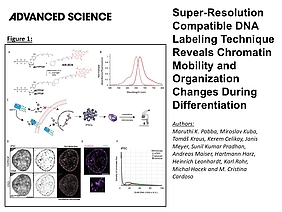New publication by the Cardoso lab on how a super-resolution compatible DNA labeling technique reveals chromatin mobility and organization changes during differentiation
Pabba MK, Kuba M, Kraus T, Celikay K, Meyer J, Pradhan SK, Maiser A, Harz H, Leonhardt H, Rohr K, Hocek M, Cardoso MC (2025) Super-Resolution Compatible DNA Labeling Technique Reveals Chromatin Mobility and Organization Changes During Differentiation. Adv Sci (Weinh) Link
Abstract:
Chromatin dynamics play a crucial role in cellular differentiation, yet tools for studying global chromatin mobility in living cells remain limited. Here, a novel probe is developeded for the metabolic labeling of chromatin and tracking its mobility during neural differentiation. The labeling system utilizes a newly developed silicon rhodamine-conjugated deoxycytidine triphosphate (dCSiRTP). It is shown that this dCTP is efficiently delivered into living human induced pluripotent stem cells (iPSCs) and neural stem cells (NSCs) via a synthetic transporter (SNTT1). Using correlative confocal microscopy and stimulated emission depletion (STED) super-resolution microscopy, the sizes of labeled chromatin domains are quantified. Time-lapse super-resolution microscopy combined with single particle tracking revealed that chromatin mobility decreases during the transition from iPSCs (pluripotent state) to NSCs and neurons (differentiated state). This reduction in mobility correlates with the differentiation state, reflecting changes in chromatin organization during cell fate commitment. Concomitant mechanistic insights obtained from micrococcal nuclease digestion assays, chromatin compaction, and histone modification analyses revealed a decrease in chromatin accessibility during neuronal differentiation. These data indicate that chromatin adopts a more constrained structure with reduced accessibility and increased heterochromatin-associated histone modifications. These findings provide new insights into chromatin regulation during neurogenesis.
Read the full paper here: https://advanced.onlinelibrary.wiley.com/doi/10.1002/advs.202505955

